Advanced Tab for OnePager Pro for Version 7.0
Contents
- 1 About the Advanced Tab-OnePager Pro
- 2 Display Options
- 2.1 Show Hover Boxes Checkbox
- 2.2 Select Associated Text Checkbox
- 2.3 Format With Times Checkbox
- 2.4 Show Time Cursor Checkbox
- 2.5 Allow Absorption Checkbox
- 2.6 Show Absorbed Dates Checkbox
- 2.7 Copy Edits To All Snapshots Checkbox
- 2.8 Clip Task/Milestone Labels at Graph Edges Checkbox
- 2.9 Overlay VST Elements Checkbox
- 2.10 Lock Background Checkbox
- 3 Task/Milestone Threshold
- 4 Warn If Import Exceeds
- 5 Warn Of Merging Tasks
- 6 Safely Combine Tasks From Different Files
- 7 Reset Unique Ids On Update
- 8 Task Representation
- 9 Default Snapshot Date
- 10 Row hiding options
- 11 Server Method Selection
- 12 Clipboard Format
- 13 Image file DPI
- 14 Related Links
About the Advanced Tab-OnePager Pro
The Advanced tab controls various other properties of the chart and looks like this:
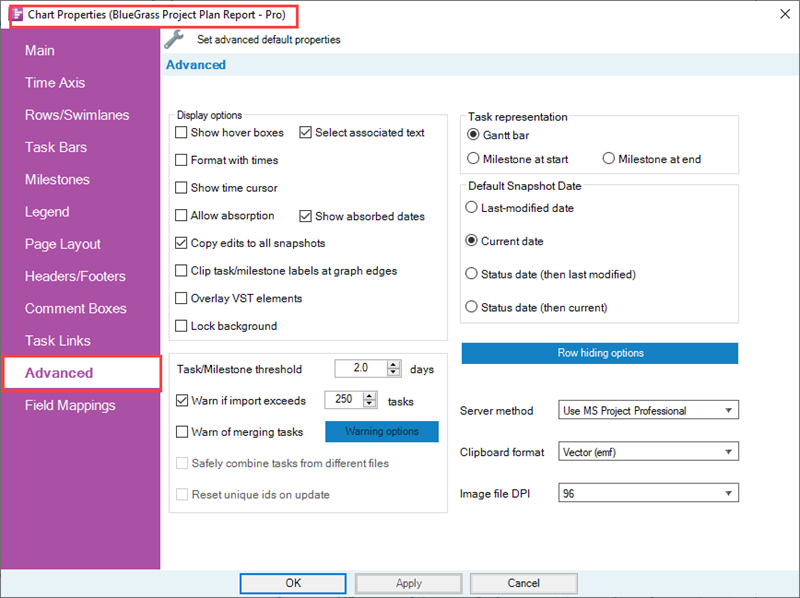
The Advanced tab shown above has several control groups that generally brings together controls by functional area. Each of these control groups and their sub-controls groups are covered in the sub-sections that follow.
Display Options
The Display Options group, shown below, contains a number of checkboxes for making ON/OFF choices governing features in the Chart Editor, various thresholds, and input/output options.
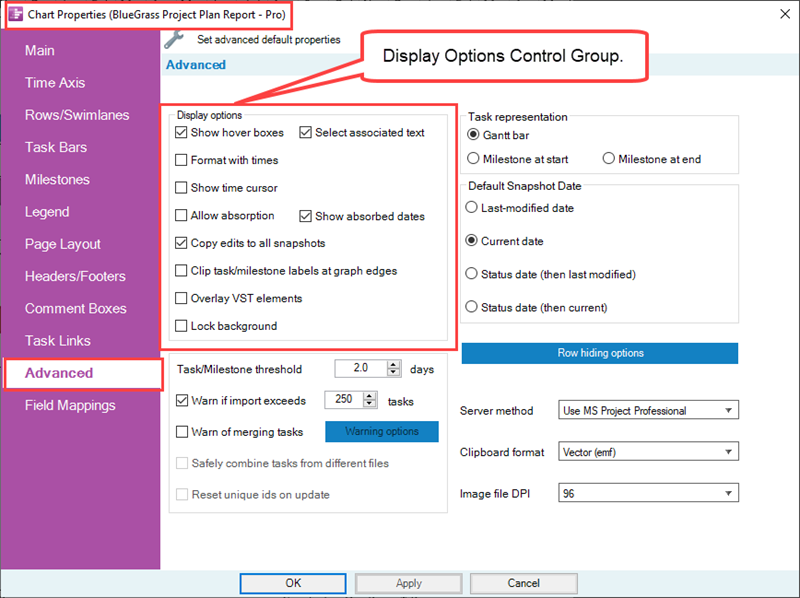
Show Hover Boxes Checkbox
The Show hover boxes checkbox controls the display of detailed information about each task bar/milestone symbol when the mouse cursor hovers over it. This information includes the Start/Finish dates, the task bar/milestone symbol name, and the Unique-ID of the task from the Microsoft Project source plan.
An example is shown below.

Select Associated Text Checkbox
OnePager provides the Select associated text checkbox control for you to change the response that a left-click on a task bar allowing a single click on the task bar to select both the task bar and its corresponding text label. When the Select associated text checkbox is checked ON, selecting a task bar/milestone symbol in the graph not only selects the task bar/milestone symbol but also its task bar name label and the other text elements if set for being displayed. When the Select associated text checkbox is checked OFF, only the selected task bar/milestone symbol is shown as selected.
For more information on selecting task bars/milestone symbols, please see the article at: Selecting Task/Milestone Shapes and Text Labels
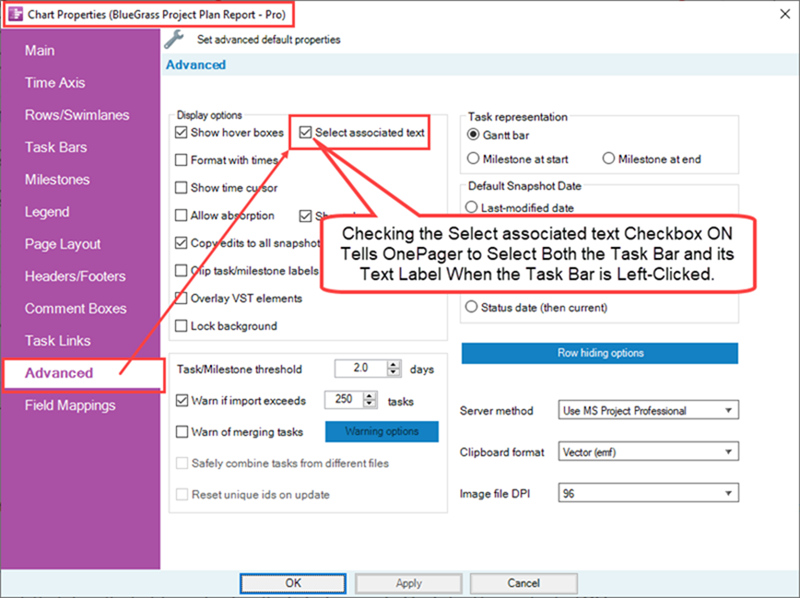
If you mouse over this checkbox the following tool tip appears: When the task bar/milestone symbol is selected, also select all text associated with the shape, including the task name, dates, and percent complete labels. As with all tool tips they are provided to assist you in determining what the control basically does.
As an example, the illustration below is a chart portion where there was a left-click on the task bar only when the Select associated text checkbox is checked OFF.

Left-clicking the task bar only selects the task bar as shown above. When the task bar is selected in the above example, only the Icons on the Home tool bar tab that are applicable to editing task bars are enabled. The enabled control groups are: Editing, Settings, Font, and Format. Even with the Select associated text checkbox checked OFF, left-clicks on the task bar still allow you to change Font properties but not text label position. You can change text label alignment if the text label is configured such that text label alignment changes are available.
However, in the situation described above, where one or more task bars are left-clicked with the Select associated text checkbox checked OFF, you can right-click on any of the selected task bar, access its normal task bar right-click context menu, and use all the commands in the context menu as well as all the tabs available in the Change Task/Milestone Properties form accessed from the Format… command in the context menu. Additionally, you can access the Change Task/Milestone Properties form by clicking the Format… Icon on the Home tool bar tab as shown below:
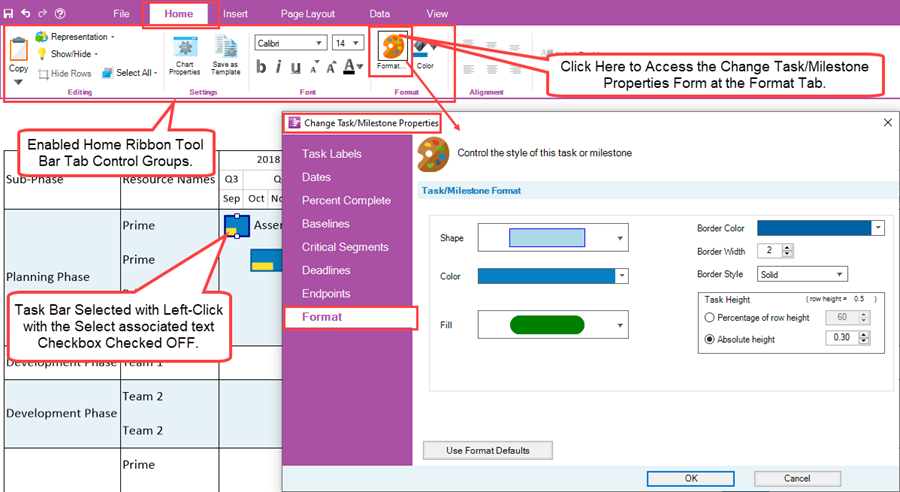
To complete the example, the illustration below is a chart portion where the Select associated text checkbox is checked ON, and the task bar is selected with a left-click:

With the Select associated text checkbox checked ON, a left-click on the task bar selects the task bar and its text label as shown above. When the task bar and text label are selected in the above example, ALL Icons on the Home tool bar tab that are applicable to editing task bars and text labels are enabled. The applicable control groups are: Editing, Settings, Font, Format, and Position.
The Alignment control group is only enabled if there is an option available to re-align the text label or text labels for selected items. Essentially, checking the Select associated text checkbox ON makes the OnePager 7.0 behavior relative to left-clicking of task bars or text labels operate the same as left-clicking only the task bar in previous versions of OnePager.
You can right-click on either the task bar or text label in this situation and the appropriate task bar or text label right-click context menu is accessed and all associated commands operate as documented including gaining access to the Change Task/Milestone Properties form. OnePager 7.0, regardless of the status of the Select associated text status of checked ON or checked OFF, permits you to right-click on any previously selected task bar or text label and accesses any of the context menu commands.
Format With Times Checkbox
When the Format with times checkbox is checked ON, the snapshot dates are displayed with a time of day component. Snapshot dates that differ by their time of day component are considered different snapshot dates.
For example, October 15, 2020 becomes October 15, 2020 5:23 PM and is a different snapshot date than October 15, 2020 6:00 PM. Note that this setting no longer controls the format of the dates on the task bars and milestone symbols. Below is an example of the Select Snapshot form displaying the date format with time:
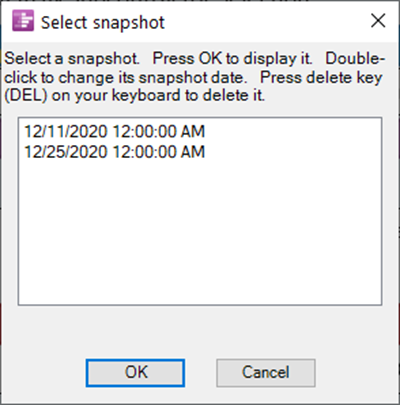
Show Time Cursor Checkbox
When the Show time cursor checkbox is checked ON, the vertical time-cursor line is shown as shown here:

Checking the Show time cursor checkbox OFF, hides the vertical time-cursor line. There is also a checkbox in the OnePager Pro View ribbon tool bar tab in the Graphic Elements group called Time Cursor that causes the vertical time-cursor line to be shown when the checkbox is checked ON as shown below:

Allow Absorption Checkbox
When the Allow absorption checkbox is checked ON, you can drag one task bar onto another task bar and be prompted to absorb the former into the latter. When the checkbox is checked OFF, this process does not take place and one task bar dragged over another is displayed as two separate task bars superimposed.
For more information on Absorbed Tasks, please see the article at: Absorbing one task into another
Show Absorbed Dates Checkbox
When the Show absorbed dates checkbox is checked ON OnePager Pro creates a Comment box associated with the absorbed task bar connected to the task bar absorbing the absorbed task bar and provides you the option of specifying the date displayed in the Comment box as shown below:

The illustration above show the result of absorbing the first task bar where a Comment box is displayed connected to the absorbing task bar. Also shown in the illustration above is a second task bar in the process of being absorbed where the Absorption Options form is shown. Making a selection from the radio buttons and clicking OK creates the second Comment box. You have the option to display the At end date, At start date, or At both start and end date.
For more information on Absorbing one task into another, please see the article at: Absorbing one task into another
Copy Edits To All Snapshots Checkbox
The Copy edits to all snapshots (CTAS) checkbox is a toggle switch that turns ON and OFF the propagation of Maverick changes to all snapshots (turned ON) or to keep maverick changes to task bars/milestone symbols in the current snapshot (turned OFF). This checkbox affects editing of these task bar/milestone symbol properties: (1) Color, (2) Shape, (2) Fill Pattern, (3) Border, (4) Text Font, (5) Task/milestone height, (6) Task Links
For more information on how CTAS applies to the new Task Links feature in OnePager Pro, please see this section in the article at: Data-Driven Task Links for OnePager Pro - Condition 2: The Copy Edits to All Snapshots (CTAS) Feature and Data-Driven Task Links
Clip Task/Milestone Labels at Graph Edges Checkbox
When the Clip task/milestone labels at graph edges checkbox is checked ON, OnePager Pro clips all task bar/milestone symbol labels that extend over the edge of the graph so that the labels no longer extend over the graph boundaries. The chart below shows how OnePager Pro handles task bar/milestone symbol labels that extend into the displayed Row/Swimlane label area when the checkbox is checked ON:

Here is the same chart with the checkbox checked OFF:

Overlay VST Elements Checkbox
When the Overlay VST elements checkbox is checked ON during the construction of a Virtual Summary Task (VST) with milestone symbols, the milestone symbols are displayed on top of the created VST bar. An example is provided below:
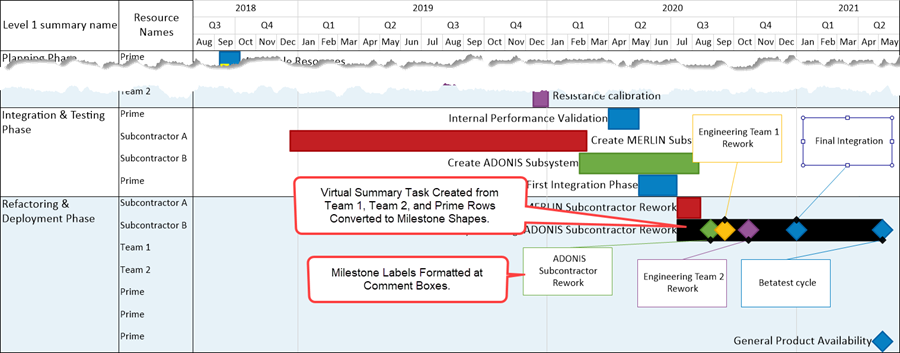
For more information on Creating and managing virtual summary tasks please see the article at: Creating and Managing Virtual Summary Tasks
Lock Background Checkbox
When the Lock background checkbox is checked ON, all Background shapes are frozen. Included are these (3) elements: images, swimlane titles, graph title, and time axis annotation. Clicking any of these elements with the mouse no longer selects them, so it becomes easier to select task bars and milestone symbols with the selection Lasso.
Task/Milestone Threshold
This numeric window controls whether short duration tasks are displayed as task bars or as milestone symbols. The unit of measure is task bar duration in number of days. With the setting shown in the Chart Properties form at the top of this article of two (2) days, any task bar in the chart that is less than two (2) days duration is displayed as a milestone symbol. Therefore, one day task bars are displayed as milestone symbols with the default settings of two (2) days. Since no duration can be less than zero (0), setting the parameter to zero (0) turns OFF all conversion of task bars into milestones symbols, which means that you can see task bars with very small width, which makes them very hard to see and to select.
Warn If Import Exceeds
This checkbox tells OnePager to provide a warning message if the number of task bars/milestone symbols imported exceeds the quantity set in the adjacent window. Recall that OnePager has the capability to make multiple pages of output both vertically and horizontally. The warning message example below is configured so that it can issue the warning if more than 10 task bars were imported.
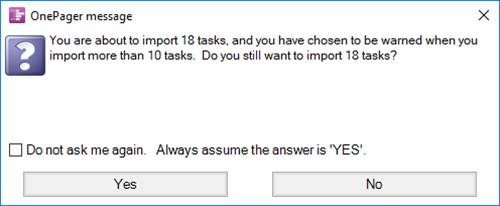
For more information on Warning Message Form, please see the sub-section in this article: Merging the Wrong Tasks into a Chart - OnePager Pro - Warning Message Form
Warn Of Merging Tasks
The checkbox shown in the Advanced tab at the beginning of this article is accompanied by a Warning options button. When this checkbox is checked ON, the Warning options button is enabled. Clicking the Warning options button accesses the Set warning thresholds form shown below:
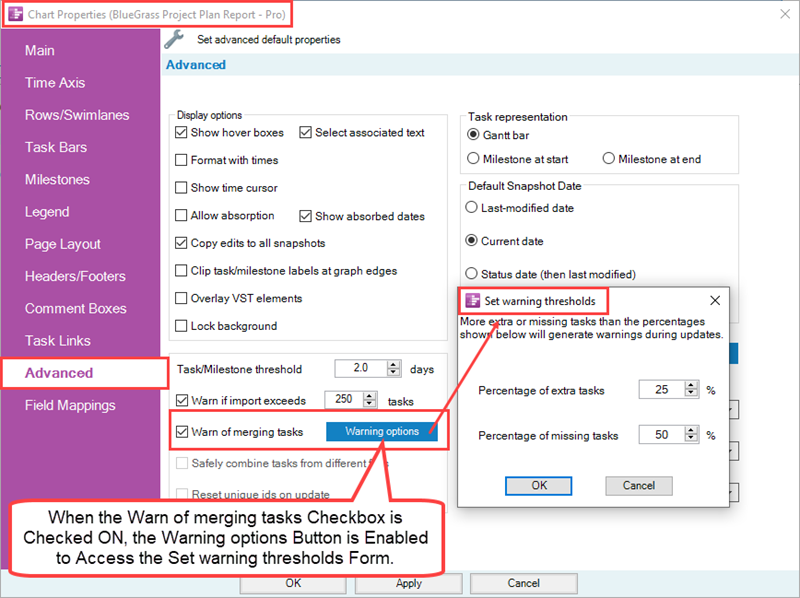
This form allows you to set your own parameters for when you wish to be warned if too many extra task bars are being merged or too many task bars are missing. Setting these percentages to 100% has the impact of turning the fixes and warning OFF. Setting the percentages to 0% provides an assurance that any extra or missing task bars triggers the fixes and warnings. When this checkbox is checked ON, OnePager looks to see if too many newly introduced task bars/milestone symbols are being imported when updating a snapshot or if too many task bars are missing per the thresholds set in the form above.
After making the calculation, OnePager provides a warning message asking if you want to proceed with the update of the snapshot or not. Additionally, the warning message also give you access to the See Extra and Missing Tasks form so you can make a fix if desired. The warning message example below was configured so that it issues the warning if more than 45 percent of the task bars differ from those of the current chart.
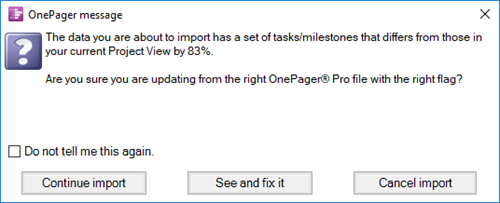
For more information on how to make fixes to these situations, please see the article at: Merging the Wrong Tasks into a Chart - OnePager Pro
Safely Combine Tasks From Different Files
The Safely combine tasks from different files checkbox is disabled in the Advanced tab of the Chart Properties form and cannot be enabled. The disabled checkbox is provided in the form for consistency so that you see that it is there. This control is enabled in the Template Properties form's Advanced tab. To avoid confusing OnePager when importing additional Microsoft Project source plans during the Replace operation, it is necessary for this feature to be ON and functioning. The reason for this is that the task bars being imported from the second Microsoft Project source plan in the Replace function have the same UniqueID numbers as the task bars from the first Microsoft Project source plan.
OnePager can be fooled into thinking that these are the same task bars (coming in from the second Microsoft Project source plan) are from the first Microsoft Project source plan when they are clearly not. Having the Safely combine tasks from different file checkbox checked ON in the Template Properties form's Advanced tab avoids confusing the identity of replacement tasks in the Replace snapshot function.
Reset Unique Ids On Update
The Reset unique ids on update checkbox is disabled in the Advanced tab of the Chart Properties form and cannot be enabled. The disabled checkbox is provided in the form for consistency so that you see that it is there. This feature can be enabled as a last resort under the situation where you are attempting to merge Microsoft Project source plans from different physical files into a single source plan where the Microsoft Project Unique IDs do not match.
Contact OnePager Support for information on how to use this rarely-used feature by referring to the article at: Getting Support
For more details on selecting alternate Unique ID fields for this purpose, please see the article at: Field Mappings Tab for OnePager Pro
For additional help, please go to the following link to the OnePager Frequently Asked Questions page: Selecting a Custom Unique ID.
If you encounter difficulties, contact our Support Team at support ticket, by e-mailing us, or by calling +1.303.779.0344.
Task Representation
The Task representation control group consists of three (3) radio buttons as shown below:
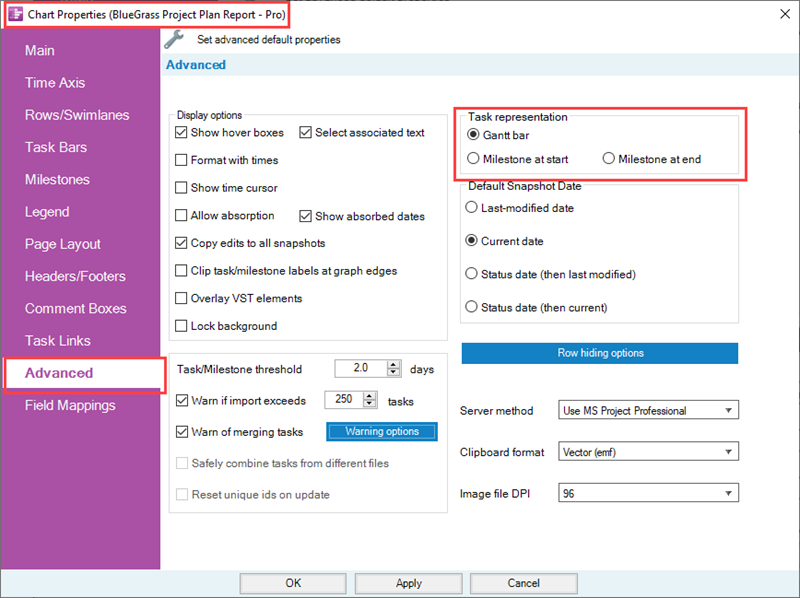
These radio buttons let you select how a task bar is represented: as a Gantt bar, by a Milestone at the start date, or a Milestone at the end date of the task bar.
Gantt Bar/Task Bar Radio Button Selection
Below is an example of a portion of a chart with task bars represented as Gantt bars:
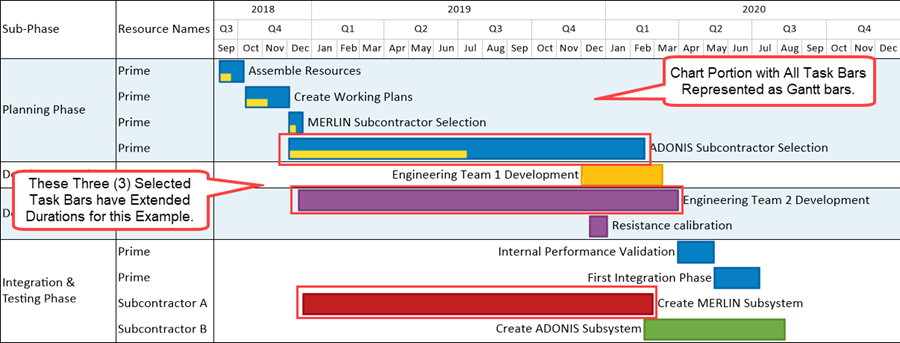
Milestone At Start Radio Button Selection
If the Milestone at start radio button is clicked ON and the tab's OK or Apply button is clicked, the portion of the chart looks like this:
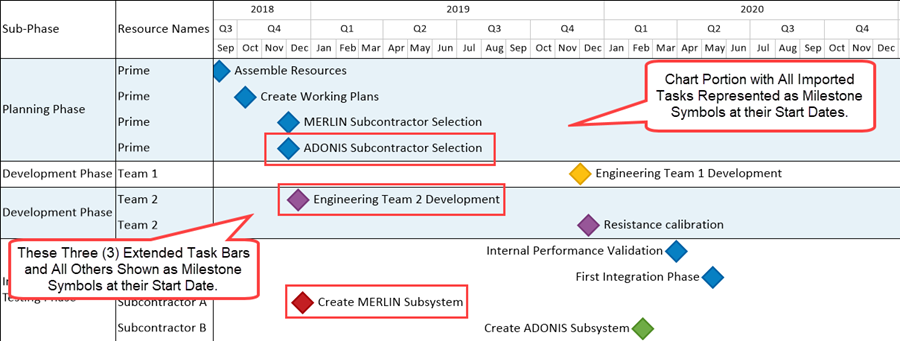
Milestone At End Radio Button Selection
If the Milestones at end radio button is clicked ON and the tab's OK or Apply button is clicked, the portion of the chart in the above illustration changes to look like this:
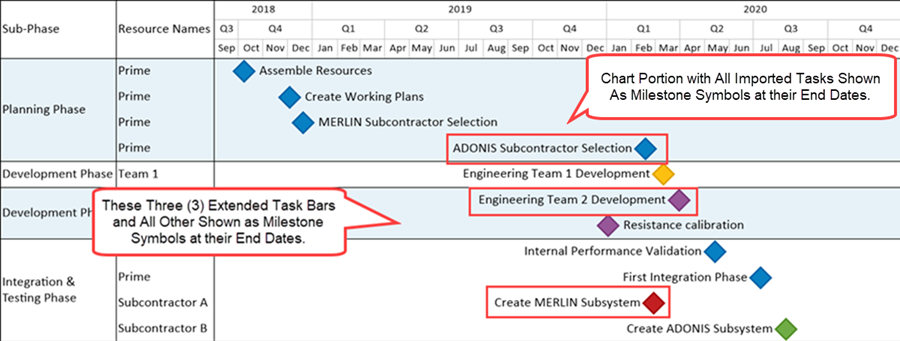
Making the selection in the Chart Properties form changes all task bars in the chart to the selected option. You can individually maverick a task bar/milestone symbol by selecting it with a right-click and use the Format ... Command in the task bar right-click context menu to access the Change task/milestone properties form to change the shape at the Format tab.
Default Snapshot Date
The Default Snapshot Date control group consists of four (4) radio buttons as shown below:
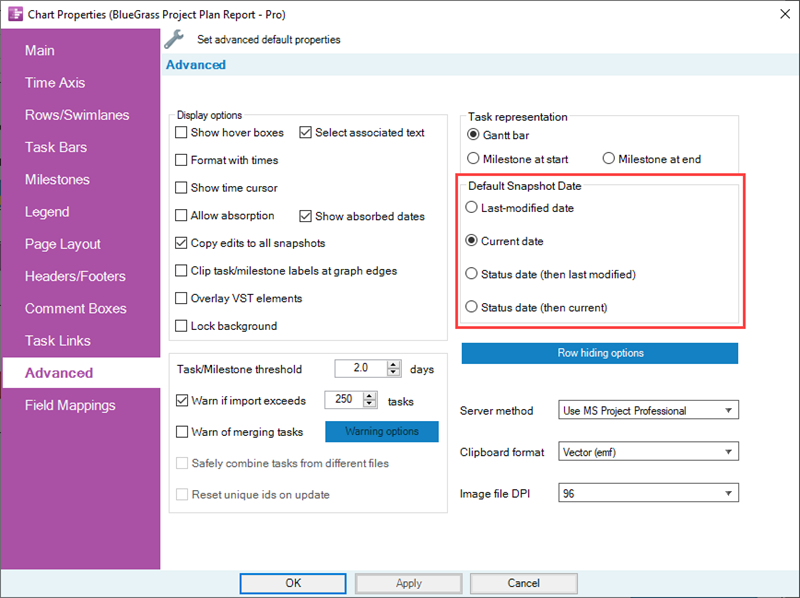
OnePager establishes the default date of the snapshot based upon data imported from the Microsoft Project source plan. You can, of course, change the snapshot date to a value different from the default date in the OnePager Choices form. In this control group you have four (4) options for setting the basis for the default snapshot date that is used for all snapshots created for this chart:
Last-Modified Date Radio Button
The Last-modified date is the date that the Microsoft Project source plan was last modified.
Current Date Radio Button
The Current date is the date when you imported the data from your Microsoft Project source plan to create the snapshot.
Status Date (Then Last Modified) Radio Button
The Status date (then last modified) is the date established in the Microsoft Project source plan for the status date of the source plan. If there is no value for the status date in the Microsoft Project source plan, OnePager uses the Last-modified date.
Status Date (Then Current) Radio Button
The Status date (then current) is the date established in the Microsoft Project source plan for the status date of the plan. If there is no value for the status date in the Microsoft Project source plan, OnePager uses the current date.
Row hiding options
The controls in this group govern the operation of automatic hiding (cropping) of rows. Access to the Row Hiding Options form is by clicking the Row hiding options button in the Chart Properties form's Advanced tab as shown below:
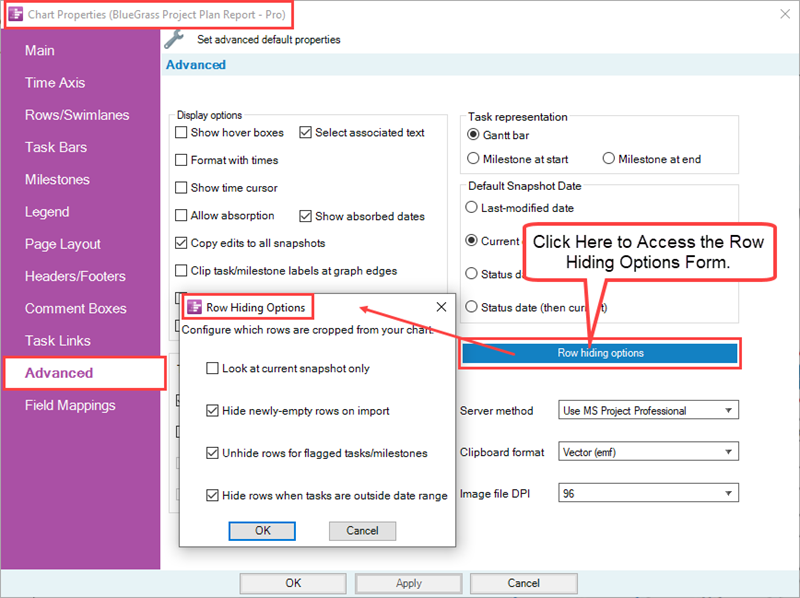
When the Row hiding options button is clicked, the Row Hiding Options form shown above appears providing you with four (4) options to select as discussed below.
Look At Current Snapshot Only Checkbox
When the Look at current snapshot only checkbox is checked ON, OnePager only examines the current snapshot when deciding which rows are empty and are candidates to be hidden. When this checkbox is OFF, OnePager considers a row empty only if it is unoccupied across all snapshots. In either case, the auto-row hiding action hides rows in all snapshots.
Hide Newly-Empty Rows On Import Checkbox
When the Hide newly-empty rows on import checkbox is checked ON, OnePager automatically hides any rows that becomes empty because task bars are missing when the chart is UPDATED. When the Hide newly-empty rows on import checkbox is OFF, OnePager leaves any empty rows that became empty because of such missing task bars alone.
Unhide Rows for Flagged Tasks/Milestones Checkbox
When the Unhide rows for flatted tasks/milestones checkbox is checked ON, OnePager automatically unhides hidden rows if they contain any of the task bars/milestone symbols that are flagged for import on the current snapshot. If the Unhide rows for flatted tasks/milestones checkbox is OFF, OnePager continues to hide previously hidden rows.
Hide Rows When Tasks Are Outside Date Range Checkbox
When the Hide rows when tasks are outside date range option is selected and the checkbox is checked ON, OnePager automatically hides any empty rows where task bars and/or milestone symbols are outside the Start date and End date established for the chart. The Start date and End date settings are either generated by OnePager based upon the range of dates provided from the source packet, set in the Chart Properties form Time Axis tab's Calendar sub-tab, or set in the OnePager Pro View ribbon tool bar tab in the Dates control group.
Accessing the Where's My Stuff?! Form
When task bars and their respective rows are hidden and subsequently cropped, the Where’s My Stuff?! form can be accessed from the OnePager Home ribbon tool bar tab in the Editing group as shown here:

For more information on the Where's My Stuff?! feature, please see the article at: Managing Hidden Tasks and Milestones Using "Where's My Stuff?!"
Server Method Selection
The Server method dropdown on the Advanced tab for OnePager Pro Add-in application lets you specify whether to use Microsoft Project Professional to read data from Microsoft Project Server/Online source plans or to directly read your project data from the server. Using Microsoft Project Professional to read the data is recommended because it makes more local custom fields available to you.
For example the numbered baseline fields (Baseline 1 Start, etc.) are generally not available when you ask OnePager Pro to read the data directly from the server but are available when you let Microsoft Project do the reading for OnePager Pro. This option is only available in OnePager Pro Add-in and not for the OnePager Pro Desktop application. To make your selection click on the dropdown and click your choice as shown below:
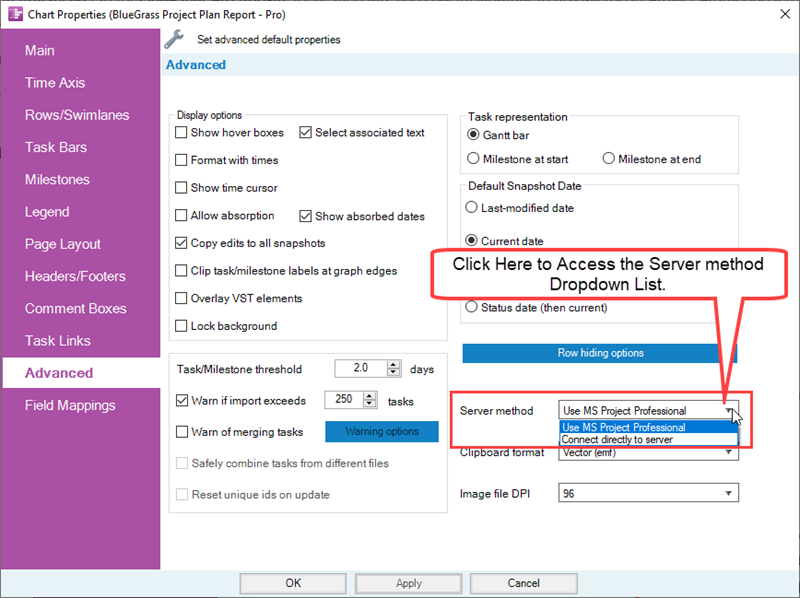
For more information on Using OnePager Pro with server resident source plans, please see the article at: Using OnePager Pro with Server Resident Project Plans (Portal)
Clipboard Format
The default clipboard format is Vector EMF (Enhanced Meta File). Essentially, this format is vector output with capabilities to retain high quality resolution when moving from the chart to PowerPoint, Word, Excel, or email messages. Although the default option is EMF format, you can change the default to the alternative option of Image PNG as shown below:
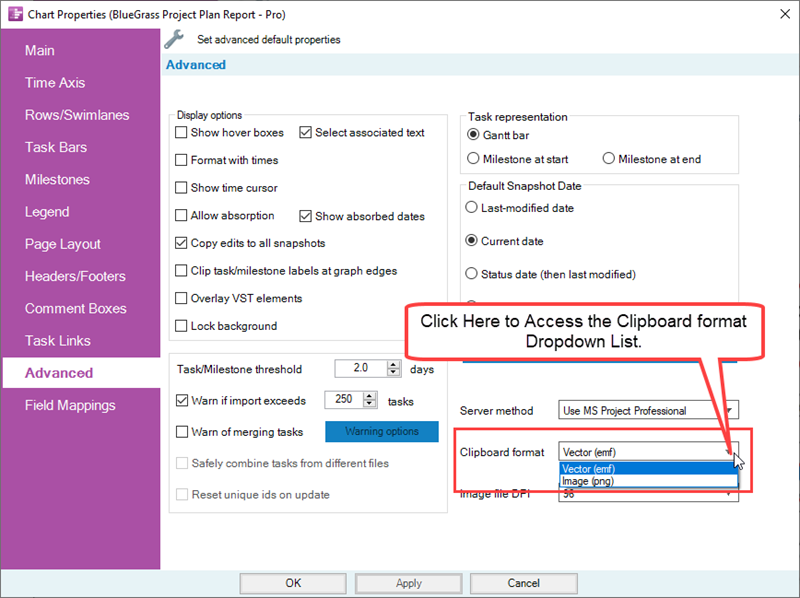
Image file DPI
This control provides the capability for you to select between three DPI settings when outputting images from OnePager to other media. The selection options are 96 DPI, 200 DPI, and 300 DPI as shown below:
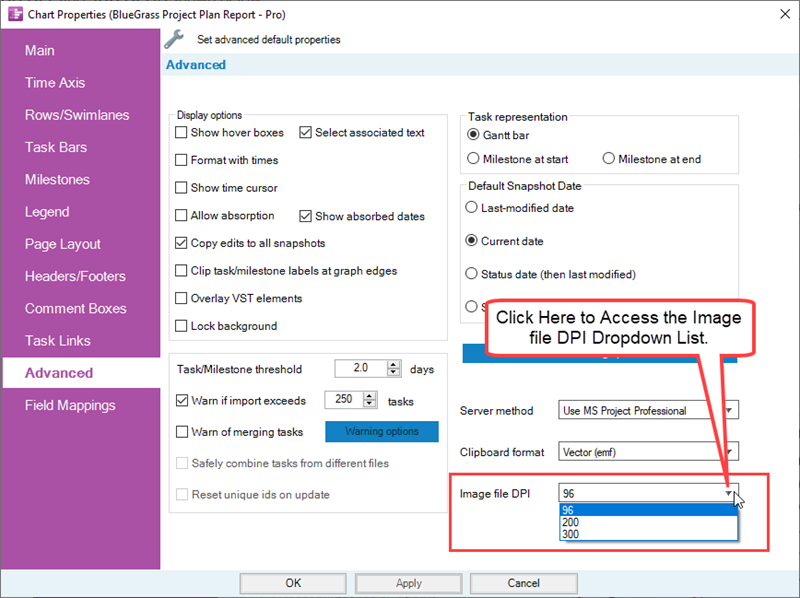
For more information on image outputs from OnePager Pro, please see the articles at: Managing Chart Data (Portal) and specifically the section at: Sharing an Image
Related Links
Absorbing one task into another
Data-Driven Task Links for OnePager Pro
Creating and Managing Virtual Summary Tasks
Merging the Wrong Tasks into a Chart - OnePager Pro
Getting Support and Contacting Chronicle Graphics
Field Mappings Tab for OnePager Pro
Selecting Task/Milestone Shapes and Text Labels
Managing Hidden Tasks and Milestones Using "Where's My Stuff?!"
Using OnePager Pro with Server Resident Project Plans (Portal)
(21.13.1-70)
- Version 7.0
- Editing the Chart
- Task/Milestone Editing
- Task/Milestone Decorations
- Time Cursor
- Absorbing/Unabsorbing
- Labels
- Backgrounds, Images, and Logos
- Sharing Output
- Virtual Summary Tasks
- Row Stripes
- Swimlane Stripes
- Color Palettes
- Hover Box
- Time Axis
- Importing
- Row/Swimlane Borders
- Hiding Rows
- Clip
- Unique ID
- Where's My Stuff?!
- Ribbon
- Snapshots
- Charts
- Templates
- Chart Properties Form
- OnePager Pro